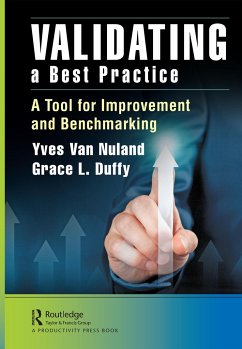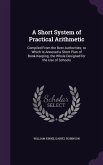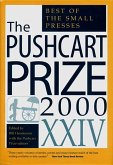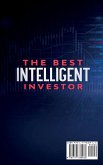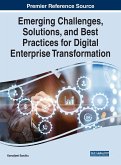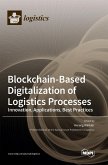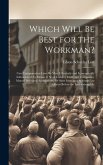- Gebundenes Buch
- Merkliste
- Auf die Merkliste
- Bewerten Bewerten
- Teilen
- Produkt teilen
- Produkterinnerung
- Produkterinnerung
Sharing Best Practices across industries and functions is an accepted approach to continuous improvement. The Benchmarking trend of the 1990s has evolved with the help of competitive analysis, performance excellence awards, and other corporate recognition programs into an ongoing documentation of what works. Bob Camp introduced benchmarking against a Best Practice based on his work at Xerox in the 1980s. Case studies abound documenting Best Practice functions and processes. Some case studies use the words "Best Practice" without evidence that the process, results, or methods are, indeed,…mehr
Andere Kunden interessierten sich auch für
![A Short System of Practical Arithmetic: Compiled From the Best Authorities; to Which Is Annexed a Short Plan of Book-Keeping. the Whole Designed for t A Short System of Practical Arithmetic: Compiled From the Best Authorities; to Which Is Annexed a Short Plan of Book-Keeping. the Whole Designed for t]() William KinneA Short System of Practical Arithmetic: Compiled From the Best Authorities; to Which Is Annexed a Short Plan of Book-Keeping. the Whole Designed for t37,99 €
William KinneA Short System of Practical Arithmetic: Compiled From the Best Authorities; to Which Is Annexed a Short Plan of Book-Keeping. the Whole Designed for t37,99 €![The Pushcart Prize XXIV The Pushcart Prize XXIV]() The Pushcart Prize XXIV26,99 €
The Pushcart Prize XXIV26,99 €![The best intelligent investor The best intelligent investor]() Bourke T. JohnsenThe best intelligent investor15,99 €
Bourke T. JohnsenThe best intelligent investor15,99 €![Best Little Marketing Book Ever Best Little Marketing Book Ever]() Fred ColdwellBest Little Marketing Book Ever29,99 €
Fred ColdwellBest Little Marketing Book Ever29,99 €![Emerging Challenges, Solutions, and Best Practices for Digital Enterprise Transformation Emerging Challenges, Solutions, and Best Practices for Digital Enterprise Transformation]() Emerging Challenges, Solutions, and Best Practices for Digital Enterprise Transformation258,99 €
Emerging Challenges, Solutions, and Best Practices for Digital Enterprise Transformation258,99 €![Blockchain-Based Digitalization of Logistics Processes-Innovation, Applications, Best Practices Blockchain-Based Digitalization of Logistics Processes-Innovation, Applications, Best Practices]() Blockchain-Based Digitalization of Logistics Processes-Innovation, Applications, Best Practices104,99 €
Blockchain-Based Digitalization of Logistics Processes-Innovation, Applications, Best Practices104,99 €![Which Will Be Best for the Workman?: Can Compensation Laws Be Most Effectively and Economically Administered by Means of Stock Liability Insurance Com Which Will Be Best for the Workman?: Can Compensation Laws Be Most Effectively and Economically Administered by Means of Stock Liability Insurance Com]() Edson Schuyler LottWhich Will Be Best for the Workman?: Can Compensation Laws Be Most Effectively and Economically Administered by Means of Stock Liability Insurance Com36,99 €
Edson Schuyler LottWhich Will Be Best for the Workman?: Can Compensation Laws Be Most Effectively and Economically Administered by Means of Stock Liability Insurance Com36,99 €-
-
-
Sharing Best Practices across industries and functions is an accepted approach to continuous improvement. The Benchmarking trend of the 1990s has evolved with the help of competitive analysis, performance excellence awards, and other corporate recognition programs into an ongoing documentation of what works. Bob Camp introduced benchmarking against a Best Practice based on his work at Xerox in the 1980s. Case studies abound documenting Best Practice functions and processes. Some case studies use the words "Best Practice" without evidence that the process, results, or methods are, indeed, superior. What is missing is a comprehensive model for assessing and writing a Best Practice that provides sufficient information to use as an effective benchmark. This book provides that comprehensive model. Today's consumers expect products and services to be of high quality, reliable, and user-friendly. This is the result of years of continuous improvement and innovation by producers. Although many organizations strive for excellent results, there is still room for improvement. Unfortunately, leaders don't always have methods and tools to measure or assess that degree of excellence. If leaders could use a tool to discover how good their approaches and methods are, and how excellent their achieved results are, they could plan further improvements. The goal is to achieve excellent results. The tool described in this book guides leaders to achieve that excellence.
Hinweis: Dieser Artikel kann nur an eine deutsche Lieferadresse ausgeliefert werden.
Hinweis: Dieser Artikel kann nur an eine deutsche Lieferadresse ausgeliefert werden.
Produktdetails
- Produktdetails
- Verlag: Productivity Press
- Seitenzahl: 280
- Erscheinungstermin: 27. Juli 2020
- Englisch
- Abmessung: 260mm x 183mm x 20mm
- Gewicht: 727g
- ISBN-13: 9780367443979
- ISBN-10: 036744397X
- Artikelnr.: 69985970
- Herstellerkennzeichnung
- Libri GmbH
- Europaallee 1
- 36244 Bad Hersfeld
- gpsr@libri.de
- Verlag: Productivity Press
- Seitenzahl: 280
- Erscheinungstermin: 27. Juli 2020
- Englisch
- Abmessung: 260mm x 183mm x 20mm
- Gewicht: 727g
- ISBN-13: 9780367443979
- ISBN-10: 036744397X
- Artikelnr.: 69985970
- Herstellerkennzeichnung
- Libri GmbH
- Europaallee 1
- 36244 Bad Hersfeld
- gpsr@libri.de
Yves Van Nuland, PhD After his studies of PhD Chemistry at the University of Leuven (Belgium) (1977), Yves worked at the Belgian FDA (1978). Next, he was laboratory and quality manager at PRB (chemical industry) (1979-1988) and quality manager at UCB Chemicals in Brussels (1989-1994). As a self-employed consultant-trainer, he gives support to his customers on subjects like excellence models (EFQM and MBA), Business Process Management, KPI's and company culture. He is coauthor and editor of the book Excellent: A Guide for the Implementation of the EFQM Excellence Model. Grace L. Duffy, President Management and Performance Systems Grace provides services in organizational and process improvement, leadership, quality, customer service and teamwork. She designs and implements effective systems for business and management success. She is author of The Quality Improvement Handbook, The Executive Guide to Improvement and Change, Executive Focus: Your Life and Career, The Public Health Quality Improvement Handbook, QFD and Lean Six Sigma for Public Health, Modular kaizen: Dealing with Disruption, Tools and Applications for Starting and Sustaining Healthy Teams, The Encyclopedia of Quality Tools, The Quality Improvement Pocket Guide, and Modular Kaizen: Continuous and Breakthrough Improvement. Ms. Duffy has over 40 years experience in successful business and process management in corporate, government, education, healthcare, not for profit, and small business. She is a recognized specialist in leadership and executive performance. Grace uses her experience as President, CEO and senior manager to assist organizations and individuals in performance excellence. She is a frequently requested keynote and conference speaker on organizational and professional performance. She is an active coach and mentor to senior leaders in large corporations as well as entrepreneurs, focusing on strategic alignment of individual skills to organizational outcomes. Grace holds a Masters in Business Administration fromGeorgiaStateUniversityand a Bachelor's in Archaeology and Anthropology fromBrighamYoungUniversity. She is an American Society for Quality (ASQ) Certified Manager of Quality/Organizational Excellence, Certified Quality Improvement Associate, and Certified Quality Auditor. Grace is a Certified Lean Six Sigma Master Black Belt, and Manager of Process Improvement. Grace is a member of ASTD, ISPI and ASQ. She is an ASQ Fellow and Past Vice President within the ASQ Office of the President and 2014 recipient of the ASQ Distinguished Service Medal.
Contents
Foreword......................................................................................................xv
Acknowledgments......................................................................................xvii
Section I DESCRIPTION OF THE BEST-TOO L
1
Introduction..................................................................................3
1.1 Why a Book on the Subject of "Best
Practice"?.................................4
1.2 What Are the Advantages of the Application of the BESTMethod
and BEST-Tool for the
Reader?..............................................5
1.3 But There Is More
.............................................................................6
1.4 Additional Applications of the
BEST-Tool..........................................6
1.5 The Book Focuses on Two Potential Audiences for Three
Major
Purposes....................................................................................6
1.6 Benchmarking, Best Practices, and Excellent
Results........................7
1.7 Objectives, Benchmarking, and
Definitions.......................................8
1.8 BEST-Method and
BEST-Tool............................................................10
1.9 Structure of the
Book........................................................................11
2 The
BEST-Method.......................................................................13
2.1 Definition of Best
Practice................................................................13
2.2 Key Concepts in the Definition of a Best
Practice...........................14
2.3 Characteristics of a Best
Practice...................................................... 15
2.4 Best Practice versus Best Technical
Product.................................... 15
2.5 BEST-Method and
BEST-Tool............................................................16
2.6 Documenting a Best
Practice............................................................17
2.7 Measurement of
Excellence..............................................................18
2.8
Enabler...............................................................................................19
2.9 The
PDCA-Method............................................................................20
2.10
Results................................................................................................20
2.11 Organizational
Maturity....................................................................23
2.12 Benefits of the
BEST-Tool.................................................................28
2.13 Use of Case Studies for Demonstrating the
BEST-Tool....................29
2.14 Why We Use Older Case
Studies......................................................30
2.15
Conclusion.........................................................................................31
3 The BEST-Tool: Checklist of Criteria for the Assessment of a
Best
Practice...............................................................................33
3.1 Assessment of the Approaches Used in a Best
Practice..................33
3.1.1
Enabler....................................................................................33
3.1.2
Plan..........................................................................................34
3.1.3
Do............................................................................................47
3.1.4
Check......................................................................................51
3.1.5
Act...........................................................................................56
3.2 Assessment of the Achieved Results
.................................................59
3.2.1
Results.....................................................................................59
3.2.2 Test of Results Criteria on a Real-Life
Example.....................66
3.2.3
Conclusion...............................................................................68
3.3 Assessment of the Management of the Best Practice Process.........68
3.3.1 Definition of a
Process...........................................................68
3.4 Assessment of the Format of a Best
Practice...................................73
3.5 Use of the BEST-Tool (Complete and Detailed
Checklist)................73
3.6 Use of the BEST Quick Scan
Tool....................................................78
3.7 Experiences, Tips, and
Tricks...........................................................80
3.7.1 Incomplete Best
Practices.......................................................80
3.7.2 Complete Best
Practices.........................................................81
3.7.3
Scores......................................................................................81
3.7.4 Realistic
Tool...........................................................................82
4 Writing a Best
Practice...............................................................83
4.1 What Is a Best
Practice?....................................................................83
4.2 A High-Level Sequence for Developing and Writing a Best
Practice..............................................................................................85
4.3 Documenting a Best Practice Case
Study........................................86
4.3.1
Title.........................................................................................87
4.3.2
Subject.....................................................................................87
4.3.3
Author......................................................................................87
4.3.4
Context....................................................................................88
4.3.5 Description of the Method and
Results.................................89
4.3.6 Measurement
Method.............................................................90
4.3.7 Process
Description..............................................................91
4.3.8 Maturity of the
Process.........................................................91
4.3.9 Key Performance Indicators (KPI) and Results....................93
4.3.10 Distribution of the
Results....................................................93
4.3.11 Cause and
Effect...................................................................93
4.3.12 Assessment of Enabler and
Results......................................94
4.3.13 Limiting
Conditions...............................................................94
4.3.14 Date and Revision
Number..................................................94
4.4 How Many Best
Practices?................................................................94
Section II USE OF THE BEST-TOO L
5 Use of the Detailed BEST-Tool: Three Case Studies....................99
5.1 Case Study 1 Organizational Culture Change at Lion Nathan
(Australia).........................................................................................100
5.1.1 Who is Lion
Nathan?...........................................................100
5.1.2 Organization of Lion
Nathan.............................................. 101
5.1.3
History.................................................................................
101
5.1.4 Three Pillars of Cultural Transformation Strategy............. 101
5.1.5 Leadership Drives Cultural Transformation....................... 101
5.1.6 Human Synergistics Measurement Instruments.................102
5.1.7 Organizational Culture Inventory® (OCI®).........................102
5.1.8 Cultural Transformation is Done in Five Phases:...............104
5.1.9 Life Styles Inventory(TM) (LSI 1 and LSI
2).............................104
5.1.10 Assessment of Case Study: Lion Nathan............................105
5.1.11 Important Preliminary
Remarks.........................................107
5.1.12 Building Block:
Enabler......................................................108
5.1.12.1 Analysis of the Plan Step of the
BEST-Method....................................................109
5.1.12.2 Analysis of the Do Step of the
BEST-Method.................................................... 112
5.1.12.3 Analysis of the Check Step of the
BEST-Method.................................................... 112
5.1.12.4 Analysis of the Act Step of the
BEST-Method.................................................... 115
5.1.13 Building Block:
Results....................................................... 115
5.1.13.1 Scope and Relevance........................................ 116
5.1.13.2
Segmentation....................................................120
5.1.13.3
Targets...............................................................120
5.1.13.4 Comparison with Benchmarks.........................121
5.1.14 Building Block: Management of Process...........................121
5.1.15 Building Block: Process
Format.........................................122
5.1.16 Summary of the Assessment of the Lion Nathan
Case Study and
Conclusion................................................122
5.2 Case Study 2: Corporate Social Responsibility at
Loblaw..............123
5.2.1 Who is
Loblaw?...................................................................124
5.2.2 Loblaw Companies CSR
Vision..........................................124
5.2.3 Loblaw
Purpose..................................................................125
5.2.4 Core Values of
Loblaw........................................................125
5.2.5 The Way of Doing
business...............................................125
5.2.6 Loblaw CSR
Pillars..............................................................125
5.2.7 CSR Annual
Reports...........................................................126
5.2.8 Long-Term Targets and Stakeholder Engagement..............127
5.2.8.1 Long-Term Targets............................................127
5.2.8.2 Stakeholder Engagement..................................127
5.2.9 What Customers Tell
Loblaw..............................................127
5.2.10 Insights from Valued
Stakeholders.....................................127
5.2.11 Moving Forward in Reduction of
the Carbon
Footprint..........................................................128
5.2.12 Improving Energy Efficiency and Cutting Carbon
Emissions.............................................................................130
5.2.13 Converting Refrigerants and Reducing Leak Intensity....... 131
5.2.14 Building Energy
Consumption........................................... 131
5.2.15 Converting Fleet to
Electric................................................ 131
5.2.16 Reducing and Diverting
Waste........................................... 131
5.2.17 Important Preliminary
Remark...........................................132
5.2.18 Assessment of the Loblaw CSR Case Study.......................132
5.2.19 Building Block 1: Enabler (22 criteria and 44
characteristics).....................................................................133
5.2.19.1 Analyze the Plan Phase of the
BEST-Method....................................................133
5.2.19.2 Analyze the Do-Step of the
BEST-Method....................................................137
5.2.19.3 Analysis of the Check Step of the
BEST-Method....................................................137
5.2.19.4 Analysis of the Act Step of the
BEST-Method....................................................139
5.2.20 Results (7 criteria and 20
characteristics)...........................140
5.2.21 Management of Process (nine
criteria)..............................140
5.2.22 Maturity of the Management of the Process......................140
5.2.23 Assessment of the Format of the Best Practice
of
Loblaw............................................................................
141
5.2.24 Summary of the Assessment of the CSR Loblaw Case
Study and
Conclusion......................................................... 141
5.2.25 Good
Practice.....................................................................
142
5.3 Case Study 3 Dream
Hotel..............................................................144
5.3.1 Organization of the
Company............................................ 145
5.3.2 Description of the Key Process Check-out........................ 150
5.3.3
Conclusion...........................................................................
159
6 Application of BEST Quick Scan Tool on Case Studies............ 161
6.1 Business Process Benchmarking: Finding and Implementing
Best Practices (Robert
Camp).......................................................... 165
6.1.1 Case Study: Housekeeping System Cycle Time
Reduction at The Ritz-Carlton Hotel Company................. 165
6.1.1.1 Who Is The Ritz-Carlton Hotel Company?....... 165
6.1.1.2 Assessment of the Case Study
The Ritz-Carlton Hotel Company.....................166
6.1.1.3
Conclusion........................................................166
6.2 Case Studies from Healthy Workplaces: A Selection of Global
Good
Practices................................................................................166
6.2.1 Case study: Lån & Spar Bank Denmark............................168
6.2.1.1 Who Is Lån & Spar Bank?................................168
6.2.1.2 Health in Business Strategy..............................169
6.2.1.3 Assessment of Case Study Lån &
Spar Bank.........................................................169
6.2.1.4
Conclusion........................................................169
6.2.2 Case Study: GlaxoSmithKline UK......................................
171
6.2.2.1 Who Is GSK?.....................................................
171
6.2.2.2 Health in Business Strategy.............................. 171
6.2.2.3 Assessment of Case Study GSK........................ 171
6.2.2.4 Conclusion........................................................
172
6.2.3 Case Study: Baxter International Inc. USA.........................
172
6.2.3.1 Who Is Baxter?..................................................
172
6.2.3.2 Health in Business Strategy.............................. 172
6.2.3.3 Assessment of Case Study Baxter
International Inc. USA...................................... 172
6.2.3.4 Conclusion........................................................
173
6.2.3.5 Conclusions from Healthy Workplaces:
A Selection of Global Good Practices.............. 173
6.3 Case Studies from APQC CONNECTING PEOPLE TO
CONTENT: Create, Surface, and Share Knowledge for a
Smarter
Organization......................................................................
173
6.3.1
Preface.................................................................................
173
6.3.2 Case study:
Nalco................................................................ 175
6.3.2.1 Initial Comment................................................ 175
6.3.2.2 Who Is Nalco?...................................................
175
6.3.2.3 Assessment of Case Study Nalco..................... 176
6.3.2.4 Conclusion Case Study Nalco........................... 176
6.3.3 Case study: MWH Global
Inc............................................. 178
6.3.3.1 Who Is MWH Global Inc.?............................... 178
6.3.3.2 Assessment of Case Study MWH Global Inc... 178
6.3.3.3 Conclusion Case MWH Global Inc.................. 179
6.3.3.4 Global Conclusion on the APQC Case
Studies (Nalco and MWH Global Inc.)............ 179
6.3.4 Case Study: Already Doing It and Not Knowing It...........180
6.3.4.1 Who Is Metro Public Health Department
(MPHD) Nashville, Tennessee?.........................180
6.3.4.2 Assessment of Case Study Metro Public
Health Department (MPHD) Nashville,
Tennessee..........................................................181
6.3.4.3 Conclusion of the Nashville, TN Case Studies...181
6.3.5 Case Study: Why Is Singapore's School System So
Successful and Is It a Model for the West?.........................183
6.3.5.1 Assessment of Case Study Singapore's
School System...................................................183
6.3.5.2
Conclusion........................................................185
6.3.5.3 Additional Comments.......................................185
6.4 Case Study: HR Certification Institute & Top Employers Institute....186
6.4.1 About
HRCI.........................................................................186
6.4.2 About Top Employers
Institute...........................................186
6.4.3 Assessment of the Case Study HR Certification
Institute & Top Employers Institute...................................188
6.4.3.1 Summary Assessment of Case Study 9............188
6.4.4 Conclusion of the Assessment of HRCI & TEI...................188
6.5 Case Study: ExxonMobil Safety, Health,
and the
Workplace..........................................................................189
6.5.1 Who Is
ExxonMobil?...........................................................189
6.5.2 Assessment of Case Study ExxonMobil Safety, Health,
and the
Workplace..............................................................189
6.5.3
Conclusion...........................................................................
191
6.6 Observations Gained from the Assessment of Ten BEST Quick
Scan
Studies.....................................................................................
191
7 Orange County Health Department Case Study.......................195
7.1 Original Case Study: Orange County Health Department, STD
Quality Improvement Case
Study................................................... 195
7.2 The
Situation....................................................................................
197
7.3 Step 1: Describe the
Problem.........................................................198
7.4 Step 2: Describe the Current
Process.............................................199
7.5 Step 3: Identify Root Cause(s) of the
Problem...............................201
7.6 Step 4: Develop a Solution and Action
Plan..................................204
7.7 Step 5: Implement the
Solution.......................................................205
7.8 Step 6: Review and Evaluate Results of the
Change......................206
7.9 Step 7: Reflect and Act on
Learnings..............................................207
7.10 Looking Back: Fall
2008..................................................................209
7.11 Apply the BEST-Method: Updating to
2019.................................... 211
7.11.1 Improvement:
Trends..........................................................213
7.11.2 Area for Improvement: Stakeholders..................................
216
7.11.3 Improvement
Audit............................................................. 218
7.12 Looking Back: Experiences from 2008 till
2019............................. 219
7.12.1 2019 Assessment of Case Study Orange County Health
Department, STD Quality Improvement............................ 219
7.12.2 Full BEST-Tool Assessment of Orange County Health
Department STD Blood Draw Process Case Study...........220
7.12.3 Current Status of Best Practice: Summer 2019..................223
7.12.4
Conclusion...........................................................................224
7.13 Lessons
Learned..............................................................................227
8
Conclusion................................................................................231
8.1 Lessons
Learned..............................................................................232
8.2 Complete Best
Practice....................................................................233
8.3 Facts and
Figures.............................................................................234
8.4
Definitions.......................................................................................234
8.5 Is This Approach
Bureaucracy?.......................................................235
8.6 "Poor" Best
Practices.......................................................................235
8.7 Journey toward
Excellence.............................................................235
8.8
Pitfalls..............................................................................................236
8.9 Super Quick
Assessment.................................................................236
8.10 Choice of the
CEO..........................................................................237
8.11 Static or
Dynamic?...........................................................................238
Appendix.........................................................................................241
Index...............................................................................................253
Foreword......................................................................................................xv
Acknowledgments......................................................................................xvii
Section I DESCRIPTION OF THE BEST-TOO L
1
Introduction..................................................................................3
1.1 Why a Book on the Subject of "Best
Practice"?.................................4
1.2 What Are the Advantages of the Application of the BESTMethod
and BEST-Tool for the
Reader?..............................................5
1.3 But There Is More
.............................................................................6
1.4 Additional Applications of the
BEST-Tool..........................................6
1.5 The Book Focuses on Two Potential Audiences for Three
Major
Purposes....................................................................................6
1.6 Benchmarking, Best Practices, and Excellent
Results........................7
1.7 Objectives, Benchmarking, and
Definitions.......................................8
1.8 BEST-Method and
BEST-Tool............................................................10
1.9 Structure of the
Book........................................................................11
2 The
BEST-Method.......................................................................13
2.1 Definition of Best
Practice................................................................13
2.2 Key Concepts in the Definition of a Best
Practice...........................14
2.3 Characteristics of a Best
Practice...................................................... 15
2.4 Best Practice versus Best Technical
Product.................................... 15
2.5 BEST-Method and
BEST-Tool............................................................16
2.6 Documenting a Best
Practice............................................................17
2.7 Measurement of
Excellence..............................................................18
2.8
Enabler...............................................................................................19
2.9 The
PDCA-Method............................................................................20
2.10
Results................................................................................................20
2.11 Organizational
Maturity....................................................................23
2.12 Benefits of the
BEST-Tool.................................................................28
2.13 Use of Case Studies for Demonstrating the
BEST-Tool....................29
2.14 Why We Use Older Case
Studies......................................................30
2.15
Conclusion.........................................................................................31
3 The BEST-Tool: Checklist of Criteria for the Assessment of a
Best
Practice...............................................................................33
3.1 Assessment of the Approaches Used in a Best
Practice..................33
3.1.1
Enabler....................................................................................33
3.1.2
Plan..........................................................................................34
3.1.3
Do............................................................................................47
3.1.4
Check......................................................................................51
3.1.5
Act...........................................................................................56
3.2 Assessment of the Achieved Results
.................................................59
3.2.1
Results.....................................................................................59
3.2.2 Test of Results Criteria on a Real-Life
Example.....................66
3.2.3
Conclusion...............................................................................68
3.3 Assessment of the Management of the Best Practice Process.........68
3.3.1 Definition of a
Process...........................................................68
3.4 Assessment of the Format of a Best
Practice...................................73
3.5 Use of the BEST-Tool (Complete and Detailed
Checklist)................73
3.6 Use of the BEST Quick Scan
Tool....................................................78
3.7 Experiences, Tips, and
Tricks...........................................................80
3.7.1 Incomplete Best
Practices.......................................................80
3.7.2 Complete Best
Practices.........................................................81
3.7.3
Scores......................................................................................81
3.7.4 Realistic
Tool...........................................................................82
4 Writing a Best
Practice...............................................................83
4.1 What Is a Best
Practice?....................................................................83
4.2 A High-Level Sequence for Developing and Writing a Best
Practice..............................................................................................85
4.3 Documenting a Best Practice Case
Study........................................86
4.3.1
Title.........................................................................................87
4.3.2
Subject.....................................................................................87
4.3.3
Author......................................................................................87
4.3.4
Context....................................................................................88
4.3.5 Description of the Method and
Results.................................89
4.3.6 Measurement
Method.............................................................90
4.3.7 Process
Description..............................................................91
4.3.8 Maturity of the
Process.........................................................91
4.3.9 Key Performance Indicators (KPI) and Results....................93
4.3.10 Distribution of the
Results....................................................93
4.3.11 Cause and
Effect...................................................................93
4.3.12 Assessment of Enabler and
Results......................................94
4.3.13 Limiting
Conditions...............................................................94
4.3.14 Date and Revision
Number..................................................94
4.4 How Many Best
Practices?................................................................94
Section II USE OF THE BEST-TOO L
5 Use of the Detailed BEST-Tool: Three Case Studies....................99
5.1 Case Study 1 Organizational Culture Change at Lion Nathan
(Australia).........................................................................................100
5.1.1 Who is Lion
Nathan?...........................................................100
5.1.2 Organization of Lion
Nathan.............................................. 101
5.1.3
History.................................................................................
101
5.1.4 Three Pillars of Cultural Transformation Strategy............. 101
5.1.5 Leadership Drives Cultural Transformation....................... 101
5.1.6 Human Synergistics Measurement Instruments.................102
5.1.7 Organizational Culture Inventory® (OCI®).........................102
5.1.8 Cultural Transformation is Done in Five Phases:...............104
5.1.9 Life Styles Inventory(TM) (LSI 1 and LSI
2).............................104
5.1.10 Assessment of Case Study: Lion Nathan............................105
5.1.11 Important Preliminary
Remarks.........................................107
5.1.12 Building Block:
Enabler......................................................108
5.1.12.1 Analysis of the Plan Step of the
BEST-Method....................................................109
5.1.12.2 Analysis of the Do Step of the
BEST-Method.................................................... 112
5.1.12.3 Analysis of the Check Step of the
BEST-Method.................................................... 112
5.1.12.4 Analysis of the Act Step of the
BEST-Method.................................................... 115
5.1.13 Building Block:
Results....................................................... 115
5.1.13.1 Scope and Relevance........................................ 116
5.1.13.2
Segmentation....................................................120
5.1.13.3
Targets...............................................................120
5.1.13.4 Comparison with Benchmarks.........................121
5.1.14 Building Block: Management of Process...........................121
5.1.15 Building Block: Process
Format.........................................122
5.1.16 Summary of the Assessment of the Lion Nathan
Case Study and
Conclusion................................................122
5.2 Case Study 2: Corporate Social Responsibility at
Loblaw..............123
5.2.1 Who is
Loblaw?...................................................................124
5.2.2 Loblaw Companies CSR
Vision..........................................124
5.2.3 Loblaw
Purpose..................................................................125
5.2.4 Core Values of
Loblaw........................................................125
5.2.5 The Way of Doing
business...............................................125
5.2.6 Loblaw CSR
Pillars..............................................................125
5.2.7 CSR Annual
Reports...........................................................126
5.2.8 Long-Term Targets and Stakeholder Engagement..............127
5.2.8.1 Long-Term Targets............................................127
5.2.8.2 Stakeholder Engagement..................................127
5.2.9 What Customers Tell
Loblaw..............................................127
5.2.10 Insights from Valued
Stakeholders.....................................127
5.2.11 Moving Forward in Reduction of
the Carbon
Footprint..........................................................128
5.2.12 Improving Energy Efficiency and Cutting Carbon
Emissions.............................................................................130
5.2.13 Converting Refrigerants and Reducing Leak Intensity....... 131
5.2.14 Building Energy
Consumption........................................... 131
5.2.15 Converting Fleet to
Electric................................................ 131
5.2.16 Reducing and Diverting
Waste........................................... 131
5.2.17 Important Preliminary
Remark...........................................132
5.2.18 Assessment of the Loblaw CSR Case Study.......................132
5.2.19 Building Block 1: Enabler (22 criteria and 44
characteristics).....................................................................133
5.2.19.1 Analyze the Plan Phase of the
BEST-Method....................................................133
5.2.19.2 Analyze the Do-Step of the
BEST-Method....................................................137
5.2.19.3 Analysis of the Check Step of the
BEST-Method....................................................137
5.2.19.4 Analysis of the Act Step of the
BEST-Method....................................................139
5.2.20 Results (7 criteria and 20
characteristics)...........................140
5.2.21 Management of Process (nine
criteria)..............................140
5.2.22 Maturity of the Management of the Process......................140
5.2.23 Assessment of the Format of the Best Practice
of
Loblaw............................................................................
141
5.2.24 Summary of the Assessment of the CSR Loblaw Case
Study and
Conclusion......................................................... 141
5.2.25 Good
Practice.....................................................................
142
5.3 Case Study 3 Dream
Hotel..............................................................144
5.3.1 Organization of the
Company............................................ 145
5.3.2 Description of the Key Process Check-out........................ 150
5.3.3
Conclusion...........................................................................
159
6 Application of BEST Quick Scan Tool on Case Studies............ 161
6.1 Business Process Benchmarking: Finding and Implementing
Best Practices (Robert
Camp).......................................................... 165
6.1.1 Case Study: Housekeeping System Cycle Time
Reduction at The Ritz-Carlton Hotel Company................. 165
6.1.1.1 Who Is The Ritz-Carlton Hotel Company?....... 165
6.1.1.2 Assessment of the Case Study
The Ritz-Carlton Hotel Company.....................166
6.1.1.3
Conclusion........................................................166
6.2 Case Studies from Healthy Workplaces: A Selection of Global
Good
Practices................................................................................166
6.2.1 Case study: Lån & Spar Bank Denmark............................168
6.2.1.1 Who Is Lån & Spar Bank?................................168
6.2.1.2 Health in Business Strategy..............................169
6.2.1.3 Assessment of Case Study Lån &
Spar Bank.........................................................169
6.2.1.4
Conclusion........................................................169
6.2.2 Case Study: GlaxoSmithKline UK......................................
171
6.2.2.1 Who Is GSK?.....................................................
171
6.2.2.2 Health in Business Strategy.............................. 171
6.2.2.3 Assessment of Case Study GSK........................ 171
6.2.2.4 Conclusion........................................................
172
6.2.3 Case Study: Baxter International Inc. USA.........................
172
6.2.3.1 Who Is Baxter?..................................................
172
6.2.3.2 Health in Business Strategy.............................. 172
6.2.3.3 Assessment of Case Study Baxter
International Inc. USA...................................... 172
6.2.3.4 Conclusion........................................................
173
6.2.3.5 Conclusions from Healthy Workplaces:
A Selection of Global Good Practices.............. 173
6.3 Case Studies from APQC CONNECTING PEOPLE TO
CONTENT: Create, Surface, and Share Knowledge for a
Smarter
Organization......................................................................
173
6.3.1
Preface.................................................................................
173
6.3.2 Case study:
Nalco................................................................ 175
6.3.2.1 Initial Comment................................................ 175
6.3.2.2 Who Is Nalco?...................................................
175
6.3.2.3 Assessment of Case Study Nalco..................... 176
6.3.2.4 Conclusion Case Study Nalco........................... 176
6.3.3 Case study: MWH Global
Inc............................................. 178
6.3.3.1 Who Is MWH Global Inc.?............................... 178
6.3.3.2 Assessment of Case Study MWH Global Inc... 178
6.3.3.3 Conclusion Case MWH Global Inc.................. 179
6.3.3.4 Global Conclusion on the APQC Case
Studies (Nalco and MWH Global Inc.)............ 179
6.3.4 Case Study: Already Doing It and Not Knowing It...........180
6.3.4.1 Who Is Metro Public Health Department
(MPHD) Nashville, Tennessee?.........................180
6.3.4.2 Assessment of Case Study Metro Public
Health Department (MPHD) Nashville,
Tennessee..........................................................181
6.3.4.3 Conclusion of the Nashville, TN Case Studies...181
6.3.5 Case Study: Why Is Singapore's School System So
Successful and Is It a Model for the West?.........................183
6.3.5.1 Assessment of Case Study Singapore's
School System...................................................183
6.3.5.2
Conclusion........................................................185
6.3.5.3 Additional Comments.......................................185
6.4 Case Study: HR Certification Institute & Top Employers Institute....186
6.4.1 About
HRCI.........................................................................186
6.4.2 About Top Employers
Institute...........................................186
6.4.3 Assessment of the Case Study HR Certification
Institute & Top Employers Institute...................................188
6.4.3.1 Summary Assessment of Case Study 9............188
6.4.4 Conclusion of the Assessment of HRCI & TEI...................188
6.5 Case Study: ExxonMobil Safety, Health,
and the
Workplace..........................................................................189
6.5.1 Who Is
ExxonMobil?...........................................................189
6.5.2 Assessment of Case Study ExxonMobil Safety, Health,
and the
Workplace..............................................................189
6.5.3
Conclusion...........................................................................
191
6.6 Observations Gained from the Assessment of Ten BEST Quick
Scan
Studies.....................................................................................
191
7 Orange County Health Department Case Study.......................195
7.1 Original Case Study: Orange County Health Department, STD
Quality Improvement Case
Study................................................... 195
7.2 The
Situation....................................................................................
197
7.3 Step 1: Describe the
Problem.........................................................198
7.4 Step 2: Describe the Current
Process.............................................199
7.5 Step 3: Identify Root Cause(s) of the
Problem...............................201
7.6 Step 4: Develop a Solution and Action
Plan..................................204
7.7 Step 5: Implement the
Solution.......................................................205
7.8 Step 6: Review and Evaluate Results of the
Change......................206
7.9 Step 7: Reflect and Act on
Learnings..............................................207
7.10 Looking Back: Fall
2008..................................................................209
7.11 Apply the BEST-Method: Updating to
2019.................................... 211
7.11.1 Improvement:
Trends..........................................................213
7.11.2 Area for Improvement: Stakeholders..................................
216
7.11.3 Improvement
Audit............................................................. 218
7.12 Looking Back: Experiences from 2008 till
2019............................. 219
7.12.1 2019 Assessment of Case Study Orange County Health
Department, STD Quality Improvement............................ 219
7.12.2 Full BEST-Tool Assessment of Orange County Health
Department STD Blood Draw Process Case Study...........220
7.12.3 Current Status of Best Practice: Summer 2019..................223
7.12.4
Conclusion...........................................................................224
7.13 Lessons
Learned..............................................................................227
8
Conclusion................................................................................231
8.1 Lessons
Learned..............................................................................232
8.2 Complete Best
Practice....................................................................233
8.3 Facts and
Figures.............................................................................234
8.4
Definitions.......................................................................................234
8.5 Is This Approach
Bureaucracy?.......................................................235
8.6 "Poor" Best
Practices.......................................................................235
8.7 Journey toward
Excellence.............................................................235
8.8
Pitfalls..............................................................................................236
8.9 Super Quick
Assessment.................................................................236
8.10 Choice of the
CEO..........................................................................237
8.11 Static or
Dynamic?...........................................................................238
Appendix.........................................................................................241
Index...............................................................................................253
Contents
Foreword......................................................................................................xv
Acknowledgments......................................................................................xvii
Section I DESCRIPTION OF THE BEST-TOO L
1
Introduction..................................................................................3
1.1 Why a Book on the Subject of "Best
Practice"?.................................4
1.2 What Are the Advantages of the Application of the BESTMethod
and BEST-Tool for the
Reader?..............................................5
1.3 But There Is More
.............................................................................6
1.4 Additional Applications of the
BEST-Tool..........................................6
1.5 The Book Focuses on Two Potential Audiences for Three
Major
Purposes....................................................................................6
1.6 Benchmarking, Best Practices, and Excellent
Results........................7
1.7 Objectives, Benchmarking, and
Definitions.......................................8
1.8 BEST-Method and
BEST-Tool............................................................10
1.9 Structure of the
Book........................................................................11
2 The
BEST-Method.......................................................................13
2.1 Definition of Best
Practice................................................................13
2.2 Key Concepts in the Definition of a Best
Practice...........................14
2.3 Characteristics of a Best
Practice...................................................... 15
2.4 Best Practice versus Best Technical
Product.................................... 15
2.5 BEST-Method and
BEST-Tool............................................................16
2.6 Documenting a Best
Practice............................................................17
2.7 Measurement of
Excellence..............................................................18
2.8
Enabler...............................................................................................19
2.9 The
PDCA-Method............................................................................20
2.10
Results................................................................................................20
2.11 Organizational
Maturity....................................................................23
2.12 Benefits of the
BEST-Tool.................................................................28
2.13 Use of Case Studies for Demonstrating the
BEST-Tool....................29
2.14 Why We Use Older Case
Studies......................................................30
2.15
Conclusion.........................................................................................31
3 The BEST-Tool: Checklist of Criteria for the Assessment of a
Best
Practice...............................................................................33
3.1 Assessment of the Approaches Used in a Best
Practice..................33
3.1.1
Enabler....................................................................................33
3.1.2
Plan..........................................................................................34
3.1.3
Do............................................................................................47
3.1.4
Check......................................................................................51
3.1.5
Act...........................................................................................56
3.2 Assessment of the Achieved Results
.................................................59
3.2.1
Results.....................................................................................59
3.2.2 Test of Results Criteria on a Real-Life
Example.....................66
3.2.3
Conclusion...............................................................................68
3.3 Assessment of the Management of the Best Practice Process.........68
3.3.1 Definition of a
Process...........................................................68
3.4 Assessment of the Format of a Best
Practice...................................73
3.5 Use of the BEST-Tool (Complete and Detailed
Checklist)................73
3.6 Use of the BEST Quick Scan
Tool....................................................78
3.7 Experiences, Tips, and
Tricks...........................................................80
3.7.1 Incomplete Best
Practices.......................................................80
3.7.2 Complete Best
Practices.........................................................81
3.7.3
Scores......................................................................................81
3.7.4 Realistic
Tool...........................................................................82
4 Writing a Best
Practice...............................................................83
4.1 What Is a Best
Practice?....................................................................83
4.2 A High-Level Sequence for Developing and Writing a Best
Practice..............................................................................................85
4.3 Documenting a Best Practice Case
Study........................................86
4.3.1
Title.........................................................................................87
4.3.2
Subject.....................................................................................87
4.3.3
Author......................................................................................87
4.3.4
Context....................................................................................88
4.3.5 Description of the Method and
Results.................................89
4.3.6 Measurement
Method.............................................................90
4.3.7 Process
Description..............................................................91
4.3.8 Maturity of the
Process.........................................................91
4.3.9 Key Performance Indicators (KPI) and Results....................93
4.3.10 Distribution of the
Results....................................................93
4.3.11 Cause and
Effect...................................................................93
4.3.12 Assessment of Enabler and
Results......................................94
4.3.13 Limiting
Conditions...............................................................94
4.3.14 Date and Revision
Number..................................................94
4.4 How Many Best
Practices?................................................................94
Section II USE OF THE BEST-TOO L
5 Use of the Detailed BEST-Tool: Three Case Studies....................99
5.1 Case Study 1 Organizational Culture Change at Lion Nathan
(Australia).........................................................................................100
5.1.1 Who is Lion
Nathan?...........................................................100
5.1.2 Organization of Lion
Nathan.............................................. 101
5.1.3
History.................................................................................
101
5.1.4 Three Pillars of Cultural Transformation Strategy............. 101
5.1.5 Leadership Drives Cultural Transformation....................... 101
5.1.6 Human Synergistics Measurement Instruments.................102
5.1.7 Organizational Culture Inventory® (OCI®).........................102
5.1.8 Cultural Transformation is Done in Five Phases:...............104
5.1.9 Life Styles Inventory(TM) (LSI 1 and LSI
2).............................104
5.1.10 Assessment of Case Study: Lion Nathan............................105
5.1.11 Important Preliminary
Remarks.........................................107
5.1.12 Building Block:
Enabler......................................................108
5.1.12.1 Analysis of the Plan Step of the
BEST-Method....................................................109
5.1.12.2 Analysis of the Do Step of the
BEST-Method.................................................... 112
5.1.12.3 Analysis of the Check Step of the
BEST-Method.................................................... 112
5.1.12.4 Analysis of the Act Step of the
BEST-Method.................................................... 115
5.1.13 Building Block:
Results....................................................... 115
5.1.13.1 Scope and Relevance........................................ 116
5.1.13.2
Segmentation....................................................120
5.1.13.3
Targets...............................................................120
5.1.13.4 Comparison with Benchmarks.........................121
5.1.14 Building Block: Management of Process...........................121
5.1.15 Building Block: Process
Format.........................................122
5.1.16 Summary of the Assessment of the Lion Nathan
Case Study and
Conclusion................................................122
5.2 Case Study 2: Corporate Social Responsibility at
Loblaw..............123
5.2.1 Who is
Loblaw?...................................................................124
5.2.2 Loblaw Companies CSR
Vision..........................................124
5.2.3 Loblaw
Purpose..................................................................125
5.2.4 Core Values of
Loblaw........................................................125
5.2.5 The Way of Doing
business...............................................125
5.2.6 Loblaw CSR
Pillars..............................................................125
5.2.7 CSR Annual
Reports...........................................................126
5.2.8 Long-Term Targets and Stakeholder Engagement..............127
5.2.8.1 Long-Term Targets............................................127
5.2.8.2 Stakeholder Engagement..................................127
5.2.9 What Customers Tell
Loblaw..............................................127
5.2.10 Insights from Valued
Stakeholders.....................................127
5.2.11 Moving Forward in Reduction of
the Carbon
Footprint..........................................................128
5.2.12 Improving Energy Efficiency and Cutting Carbon
Emissions.............................................................................130
5.2.13 Converting Refrigerants and Reducing Leak Intensity....... 131
5.2.14 Building Energy
Consumption........................................... 131
5.2.15 Converting Fleet to
Electric................................................ 131
5.2.16 Reducing and Diverting
Waste........................................... 131
5.2.17 Important Preliminary
Remark...........................................132
5.2.18 Assessment of the Loblaw CSR Case Study.......................132
5.2.19 Building Block 1: Enabler (22 criteria and 44
characteristics).....................................................................133
5.2.19.1 Analyze the Plan Phase of the
BEST-Method....................................................133
5.2.19.2 Analyze the Do-Step of the
BEST-Method....................................................137
5.2.19.3 Analysis of the Check Step of the
BEST-Method....................................................137
5.2.19.4 Analysis of the Act Step of the
BEST-Method....................................................139
5.2.20 Results (7 criteria and 20
characteristics)...........................140
5.2.21 Management of Process (nine
criteria)..............................140
5.2.22 Maturity of the Management of the Process......................140
5.2.23 Assessment of the Format of the Best Practice
of
Loblaw............................................................................
141
5.2.24 Summary of the Assessment of the CSR Loblaw Case
Study and
Conclusion......................................................... 141
5.2.25 Good
Practice.....................................................................
142
5.3 Case Study 3 Dream
Hotel..............................................................144
5.3.1 Organization of the
Company............................................ 145
5.3.2 Description of the Key Process Check-out........................ 150
5.3.3
Conclusion...........................................................................
159
6 Application of BEST Quick Scan Tool on Case Studies............ 161
6.1 Business Process Benchmarking: Finding and Implementing
Best Practices (Robert
Camp).......................................................... 165
6.1.1 Case Study: Housekeeping System Cycle Time
Reduction at The Ritz-Carlton Hotel Company................. 165
6.1.1.1 Who Is The Ritz-Carlton Hotel Company?....... 165
6.1.1.2 Assessment of the Case Study
The Ritz-Carlton Hotel Company.....................166
6.1.1.3
Conclusion........................................................166
6.2 Case Studies from Healthy Workplaces: A Selection of Global
Good
Practices................................................................................166
6.2.1 Case study: Lån & Spar Bank Denmark............................168
6.2.1.1 Who Is Lån & Spar Bank?................................168
6.2.1.2 Health in Business Strategy..............................169
6.2.1.3 Assessment of Case Study Lån &
Spar Bank.........................................................169
6.2.1.4
Conclusion........................................................169
6.2.2 Case Study: GlaxoSmithKline UK......................................
171
6.2.2.1 Who Is GSK?.....................................................
171
6.2.2.2 Health in Business Strategy.............................. 171
6.2.2.3 Assessment of Case Study GSK........................ 171
6.2.2.4 Conclusion........................................................
172
6.2.3 Case Study: Baxter International Inc. USA.........................
172
6.2.3.1 Who Is Baxter?..................................................
172
6.2.3.2 Health in Business Strategy.............................. 172
6.2.3.3 Assessment of Case Study Baxter
International Inc. USA...................................... 172
6.2.3.4 Conclusion........................................................
173
6.2.3.5 Conclusions from Healthy Workplaces:
A Selection of Global Good Practices.............. 173
6.3 Case Studies from APQC CONNECTING PEOPLE TO
CONTENT: Create, Surface, and Share Knowledge for a
Smarter
Organization......................................................................
173
6.3.1
Preface.................................................................................
173
6.3.2 Case study:
Nalco................................................................ 175
6.3.2.1 Initial Comment................................................ 175
6.3.2.2 Who Is Nalco?...................................................
175
6.3.2.3 Assessment of Case Study Nalco..................... 176
6.3.2.4 Conclusion Case Study Nalco........................... 176
6.3.3 Case study: MWH Global
Inc............................................. 178
6.3.3.1 Who Is MWH Global Inc.?............................... 178
6.3.3.2 Assessment of Case Study MWH Global Inc... 178
6.3.3.3 Conclusion Case MWH Global Inc.................. 179
6.3.3.4 Global Conclusion on the APQC Case
Studies (Nalco and MWH Global Inc.)............ 179
6.3.4 Case Study: Already Doing It and Not Knowing It...........180
6.3.4.1 Who Is Metro Public Health Department
(MPHD) Nashville, Tennessee?.........................180
6.3.4.2 Assessment of Case Study Metro Public
Health Department (MPHD) Nashville,
Tennessee..........................................................181
6.3.4.3 Conclusion of the Nashville, TN Case Studies...181
6.3.5 Case Study: Why Is Singapore's School System So
Successful and Is It a Model for the West?.........................183
6.3.5.1 Assessment of Case Study Singapore's
School System...................................................183
6.3.5.2
Conclusion........................................................185
6.3.5.3 Additional Comments.......................................185
6.4 Case Study: HR Certification Institute & Top Employers Institute....186
6.4.1 About
HRCI.........................................................................186
6.4.2 About Top Employers
Institute...........................................186
6.4.3 Assessment of the Case Study HR Certification
Institute & Top Employers Institute...................................188
6.4.3.1 Summary Assessment of Case Study 9............188
6.4.4 Conclusion of the Assessment of HRCI & TEI...................188
6.5 Case Study: ExxonMobil Safety, Health,
and the
Workplace..........................................................................189
6.5.1 Who Is
ExxonMobil?...........................................................189
6.5.2 Assessment of Case Study ExxonMobil Safety, Health,
and the
Workplace..............................................................189
6.5.3
Conclusion...........................................................................
191
6.6 Observations Gained from the Assessment of Ten BEST Quick
Scan
Studies.....................................................................................
191
7 Orange County Health Department Case Study.......................195
7.1 Original Case Study: Orange County Health Department, STD
Quality Improvement Case
Study................................................... 195
7.2 The
Situation....................................................................................
197
7.3 Step 1: Describe the
Problem.........................................................198
7.4 Step 2: Describe the Current
Process.............................................199
7.5 Step 3: Identify Root Cause(s) of the
Problem...............................201
7.6 Step 4: Develop a Solution and Action
Plan..................................204
7.7 Step 5: Implement the
Solution.......................................................205
7.8 Step 6: Review and Evaluate Results of the
Change......................206
7.9 Step 7: Reflect and Act on
Learnings..............................................207
7.10 Looking Back: Fall
2008..................................................................209
7.11 Apply the BEST-Method: Updating to
2019.................................... 211
7.11.1 Improvement:
Trends..........................................................213
7.11.2 Area for Improvement: Stakeholders..................................
216
7.11.3 Improvement
Audit............................................................. 218
7.12 Looking Back: Experiences from 2008 till
2019............................. 219
7.12.1 2019 Assessment of Case Study Orange County Health
Department, STD Quality Improvement............................ 219
7.12.2 Full BEST-Tool Assessment of Orange County Health
Department STD Blood Draw Process Case Study...........220
7.12.3 Current Status of Best Practice: Summer 2019..................223
7.12.4
Conclusion...........................................................................224
7.13 Lessons
Learned..............................................................................227
8
Conclusion................................................................................231
8.1 Lessons
Learned..............................................................................232
8.2 Complete Best
Practice....................................................................233
8.3 Facts and
Figures.............................................................................234
8.4
Definitions.......................................................................................234
8.5 Is This Approach
Bureaucracy?.......................................................235
8.6 "Poor" Best
Practices.......................................................................235
8.7 Journey toward
Excellence.............................................................235
8.8
Pitfalls..............................................................................................236
8.9 Super Quick
Assessment.................................................................236
8.10 Choice of the
CEO..........................................................................237
8.11 Static or
Dynamic?...........................................................................238
Appendix.........................................................................................241
Index...............................................................................................253
Foreword......................................................................................................xv
Acknowledgments......................................................................................xvii
Section I DESCRIPTION OF THE BEST-TOO L
1
Introduction..................................................................................3
1.1 Why a Book on the Subject of "Best
Practice"?.................................4
1.2 What Are the Advantages of the Application of the BESTMethod
and BEST-Tool for the
Reader?..............................................5
1.3 But There Is More
.............................................................................6
1.4 Additional Applications of the
BEST-Tool..........................................6
1.5 The Book Focuses on Two Potential Audiences for Three
Major
Purposes....................................................................................6
1.6 Benchmarking, Best Practices, and Excellent
Results........................7
1.7 Objectives, Benchmarking, and
Definitions.......................................8
1.8 BEST-Method and
BEST-Tool............................................................10
1.9 Structure of the
Book........................................................................11
2 The
BEST-Method.......................................................................13
2.1 Definition of Best
Practice................................................................13
2.2 Key Concepts in the Definition of a Best
Practice...........................14
2.3 Characteristics of a Best
Practice...................................................... 15
2.4 Best Practice versus Best Technical
Product.................................... 15
2.5 BEST-Method and
BEST-Tool............................................................16
2.6 Documenting a Best
Practice............................................................17
2.7 Measurement of
Excellence..............................................................18
2.8
Enabler...............................................................................................19
2.9 The
PDCA-Method............................................................................20
2.10
Results................................................................................................20
2.11 Organizational
Maturity....................................................................23
2.12 Benefits of the
BEST-Tool.................................................................28
2.13 Use of Case Studies for Demonstrating the
BEST-Tool....................29
2.14 Why We Use Older Case
Studies......................................................30
2.15
Conclusion.........................................................................................31
3 The BEST-Tool: Checklist of Criteria for the Assessment of a
Best
Practice...............................................................................33
3.1 Assessment of the Approaches Used in a Best
Practice..................33
3.1.1
Enabler....................................................................................33
3.1.2
Plan..........................................................................................34
3.1.3
Do............................................................................................47
3.1.4
Check......................................................................................51
3.1.5
Act...........................................................................................56
3.2 Assessment of the Achieved Results
.................................................59
3.2.1
Results.....................................................................................59
3.2.2 Test of Results Criteria on a Real-Life
Example.....................66
3.2.3
Conclusion...............................................................................68
3.3 Assessment of the Management of the Best Practice Process.........68
3.3.1 Definition of a
Process...........................................................68
3.4 Assessment of the Format of a Best
Practice...................................73
3.5 Use of the BEST-Tool (Complete and Detailed
Checklist)................73
3.6 Use of the BEST Quick Scan
Tool....................................................78
3.7 Experiences, Tips, and
Tricks...........................................................80
3.7.1 Incomplete Best
Practices.......................................................80
3.7.2 Complete Best
Practices.........................................................81
3.7.3
Scores......................................................................................81
3.7.4 Realistic
Tool...........................................................................82
4 Writing a Best
Practice...............................................................83
4.1 What Is a Best
Practice?....................................................................83
4.2 A High-Level Sequence for Developing and Writing a Best
Practice..............................................................................................85
4.3 Documenting a Best Practice Case
Study........................................86
4.3.1
Title.........................................................................................87
4.3.2
Subject.....................................................................................87
4.3.3
Author......................................................................................87
4.3.4
Context....................................................................................88
4.3.5 Description of the Method and
Results.................................89
4.3.6 Measurement
Method.............................................................90
4.3.7 Process
Description..............................................................91
4.3.8 Maturity of the
Process.........................................................91
4.3.9 Key Performance Indicators (KPI) and Results....................93
4.3.10 Distribution of the
Results....................................................93
4.3.11 Cause and
Effect...................................................................93
4.3.12 Assessment of Enabler and
Results......................................94
4.3.13 Limiting
Conditions...............................................................94
4.3.14 Date and Revision
Number..................................................94
4.4 How Many Best
Practices?................................................................94
Section II USE OF THE BEST-TOO L
5 Use of the Detailed BEST-Tool: Three Case Studies....................99
5.1 Case Study 1 Organizational Culture Change at Lion Nathan
(Australia).........................................................................................100
5.1.1 Who is Lion
Nathan?...........................................................100
5.1.2 Organization of Lion
Nathan.............................................. 101
5.1.3
History.................................................................................
101
5.1.4 Three Pillars of Cultural Transformation Strategy............. 101
5.1.5 Leadership Drives Cultural Transformation....................... 101
5.1.6 Human Synergistics Measurement Instruments.................102
5.1.7 Organizational Culture Inventory® (OCI®).........................102
5.1.8 Cultural Transformation is Done in Five Phases:...............104
5.1.9 Life Styles Inventory(TM) (LSI 1 and LSI
2).............................104
5.1.10 Assessment of Case Study: Lion Nathan............................105
5.1.11 Important Preliminary
Remarks.........................................107
5.1.12 Building Block:
Enabler......................................................108
5.1.12.1 Analysis of the Plan Step of the
BEST-Method....................................................109
5.1.12.2 Analysis of the Do Step of the
BEST-Method.................................................... 112
5.1.12.3 Analysis of the Check Step of the
BEST-Method.................................................... 112
5.1.12.4 Analysis of the Act Step of the
BEST-Method.................................................... 115
5.1.13 Building Block:
Results....................................................... 115
5.1.13.1 Scope and Relevance........................................ 116
5.1.13.2
Segmentation....................................................120
5.1.13.3
Targets...............................................................120
5.1.13.4 Comparison with Benchmarks.........................121
5.1.14 Building Block: Management of Process...........................121
5.1.15 Building Block: Process
Format.........................................122
5.1.16 Summary of the Assessment of the Lion Nathan
Case Study and
Conclusion................................................122
5.2 Case Study 2: Corporate Social Responsibility at
Loblaw..............123
5.2.1 Who is
Loblaw?...................................................................124
5.2.2 Loblaw Companies CSR
Vision..........................................124
5.2.3 Loblaw
Purpose..................................................................125
5.2.4 Core Values of
Loblaw........................................................125
5.2.5 The Way of Doing
business...............................................125
5.2.6 Loblaw CSR
Pillars..............................................................125
5.2.7 CSR Annual
Reports...........................................................126
5.2.8 Long-Term Targets and Stakeholder Engagement..............127
5.2.8.1 Long-Term Targets............................................127
5.2.8.2 Stakeholder Engagement..................................127
5.2.9 What Customers Tell
Loblaw..............................................127
5.2.10 Insights from Valued
Stakeholders.....................................127
5.2.11 Moving Forward in Reduction of
the Carbon
Footprint..........................................................128
5.2.12 Improving Energy Efficiency and Cutting Carbon
Emissions.............................................................................130
5.2.13 Converting Refrigerants and Reducing Leak Intensity....... 131
5.2.14 Building Energy
Consumption........................................... 131
5.2.15 Converting Fleet to
Electric................................................ 131
5.2.16 Reducing and Diverting
Waste........................................... 131
5.2.17 Important Preliminary
Remark...........................................132
5.2.18 Assessment of the Loblaw CSR Case Study.......................132
5.2.19 Building Block 1: Enabler (22 criteria and 44
characteristics).....................................................................133
5.2.19.1 Analyze the Plan Phase of the
BEST-Method....................................................133
5.2.19.2 Analyze the Do-Step of the
BEST-Method....................................................137
5.2.19.3 Analysis of the Check Step of the
BEST-Method....................................................137
5.2.19.4 Analysis of the Act Step of the
BEST-Method....................................................139
5.2.20 Results (7 criteria and 20
characteristics)...........................140
5.2.21 Management of Process (nine
criteria)..............................140
5.2.22 Maturity of the Management of the Process......................140
5.2.23 Assessment of the Format of the Best Practice
of
Loblaw............................................................................
141
5.2.24 Summary of the Assessment of the CSR Loblaw Case
Study and
Conclusion......................................................... 141
5.2.25 Good
Practice.....................................................................
142
5.3 Case Study 3 Dream
Hotel..............................................................144
5.3.1 Organization of the
Company............................................ 145
5.3.2 Description of the Key Process Check-out........................ 150
5.3.3
Conclusion...........................................................................
159
6 Application of BEST Quick Scan Tool on Case Studies............ 161
6.1 Business Process Benchmarking: Finding and Implementing
Best Practices (Robert
Camp).......................................................... 165
6.1.1 Case Study: Housekeeping System Cycle Time
Reduction at The Ritz-Carlton Hotel Company................. 165
6.1.1.1 Who Is The Ritz-Carlton Hotel Company?....... 165
6.1.1.2 Assessment of the Case Study
The Ritz-Carlton Hotel Company.....................166
6.1.1.3
Conclusion........................................................166
6.2 Case Studies from Healthy Workplaces: A Selection of Global
Good
Practices................................................................................166
6.2.1 Case study: Lån & Spar Bank Denmark............................168
6.2.1.1 Who Is Lån & Spar Bank?................................168
6.2.1.2 Health in Business Strategy..............................169
6.2.1.3 Assessment of Case Study Lån &
Spar Bank.........................................................169
6.2.1.4
Conclusion........................................................169
6.2.2 Case Study: GlaxoSmithKline UK......................................
171
6.2.2.1 Who Is GSK?.....................................................
171
6.2.2.2 Health in Business Strategy.............................. 171
6.2.2.3 Assessment of Case Study GSK........................ 171
6.2.2.4 Conclusion........................................................
172
6.2.3 Case Study: Baxter International Inc. USA.........................
172
6.2.3.1 Who Is Baxter?..................................................
172
6.2.3.2 Health in Business Strategy.............................. 172
6.2.3.3 Assessment of Case Study Baxter
International Inc. USA...................................... 172
6.2.3.4 Conclusion........................................................
173
6.2.3.5 Conclusions from Healthy Workplaces:
A Selection of Global Good Practices.............. 173
6.3 Case Studies from APQC CONNECTING PEOPLE TO
CONTENT: Create, Surface, and Share Knowledge for a
Smarter
Organization......................................................................
173
6.3.1
Preface.................................................................................
173
6.3.2 Case study:
Nalco................................................................ 175
6.3.2.1 Initial Comment................................................ 175
6.3.2.2 Who Is Nalco?...................................................
175
6.3.2.3 Assessment of Case Study Nalco..................... 176
6.3.2.4 Conclusion Case Study Nalco........................... 176
6.3.3 Case study: MWH Global
Inc............................................. 178
6.3.3.1 Who Is MWH Global Inc.?............................... 178
6.3.3.2 Assessment of Case Study MWH Global Inc... 178
6.3.3.3 Conclusion Case MWH Global Inc.................. 179
6.3.3.4 Global Conclusion on the APQC Case
Studies (Nalco and MWH Global Inc.)............ 179
6.3.4 Case Study: Already Doing It and Not Knowing It...........180
6.3.4.1 Who Is Metro Public Health Department
(MPHD) Nashville, Tennessee?.........................180
6.3.4.2 Assessment of Case Study Metro Public
Health Department (MPHD) Nashville,
Tennessee..........................................................181
6.3.4.3 Conclusion of the Nashville, TN Case Studies...181
6.3.5 Case Study: Why Is Singapore's School System So
Successful and Is It a Model for the West?.........................183
6.3.5.1 Assessment of Case Study Singapore's
School System...................................................183
6.3.5.2
Conclusion........................................................185
6.3.5.3 Additional Comments.......................................185
6.4 Case Study: HR Certification Institute & Top Employers Institute....186
6.4.1 About
HRCI.........................................................................186
6.4.2 About Top Employers
Institute...........................................186
6.4.3 Assessment of the Case Study HR Certification
Institute & Top Employers Institute...................................188
6.4.3.1 Summary Assessment of Case Study 9............188
6.4.4 Conclusion of the Assessment of HRCI & TEI...................188
6.5 Case Study: ExxonMobil Safety, Health,
and the
Workplace..........................................................................189
6.5.1 Who Is
ExxonMobil?...........................................................189
6.5.2 Assessment of Case Study ExxonMobil Safety, Health,
and the
Workplace..............................................................189
6.5.3
Conclusion...........................................................................
191
6.6 Observations Gained from the Assessment of Ten BEST Quick
Scan
Studies.....................................................................................
191
7 Orange County Health Department Case Study.......................195
7.1 Original Case Study: Orange County Health Department, STD
Quality Improvement Case
Study................................................... 195
7.2 The
Situation....................................................................................
197
7.3 Step 1: Describe the
Problem.........................................................198
7.4 Step 2: Describe the Current
Process.............................................199
7.5 Step 3: Identify Root Cause(s) of the
Problem...............................201
7.6 Step 4: Develop a Solution and Action
Plan..................................204
7.7 Step 5: Implement the
Solution.......................................................205
7.8 Step 6: Review and Evaluate Results of the
Change......................206
7.9 Step 7: Reflect and Act on
Learnings..............................................207
7.10 Looking Back: Fall
2008..................................................................209
7.11 Apply the BEST-Method: Updating to
2019.................................... 211
7.11.1 Improvement:
Trends..........................................................213
7.11.2 Area for Improvement: Stakeholders..................................
216
7.11.3 Improvement
Audit............................................................. 218
7.12 Looking Back: Experiences from 2008 till
2019............................. 219
7.12.1 2019 Assessment of Case Study Orange County Health
Department, STD Quality Improvement............................ 219
7.12.2 Full BEST-Tool Assessment of Orange County Health
Department STD Blood Draw Process Case Study...........220
7.12.3 Current Status of Best Practice: Summer 2019..................223
7.12.4
Conclusion...........................................................................224
7.13 Lessons
Learned..............................................................................227
8
Conclusion................................................................................231
8.1 Lessons
Learned..............................................................................232
8.2 Complete Best
Practice....................................................................233
8.3 Facts and
Figures.............................................................................234
8.4
Definitions.......................................................................................234
8.5 Is This Approach
Bureaucracy?.......................................................235
8.6 "Poor" Best
Practices.......................................................................235
8.7 Journey toward
Excellence.............................................................235
8.8
Pitfalls..............................................................................................236
8.9 Super Quick
Assessment.................................................................236
8.10 Choice of the
CEO..........................................................................237
8.11 Static or
Dynamic?...........................................................................238
Appendix.........................................................................................241
Index...............................................................................................253

